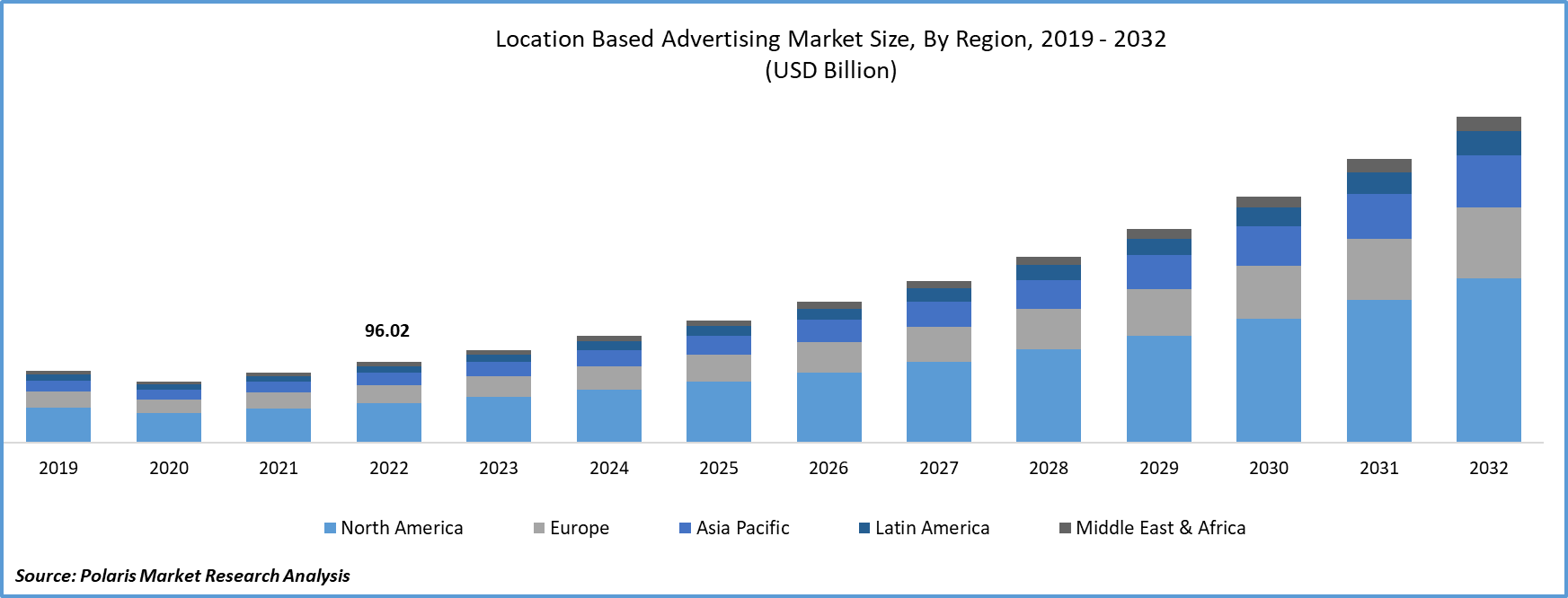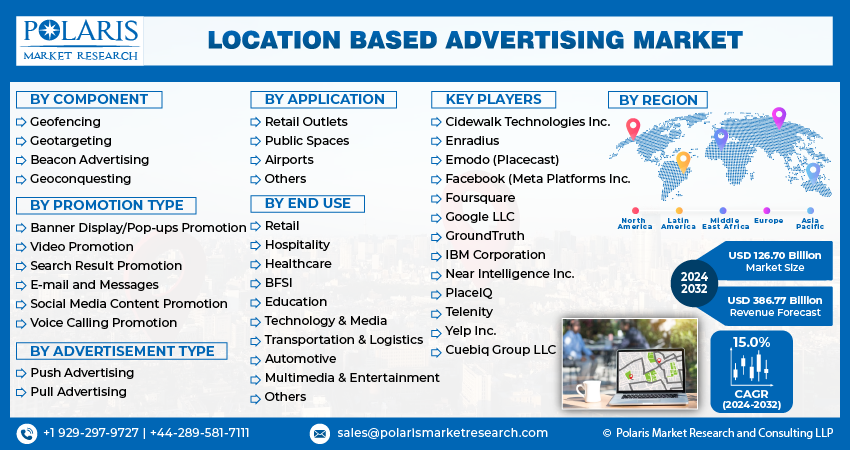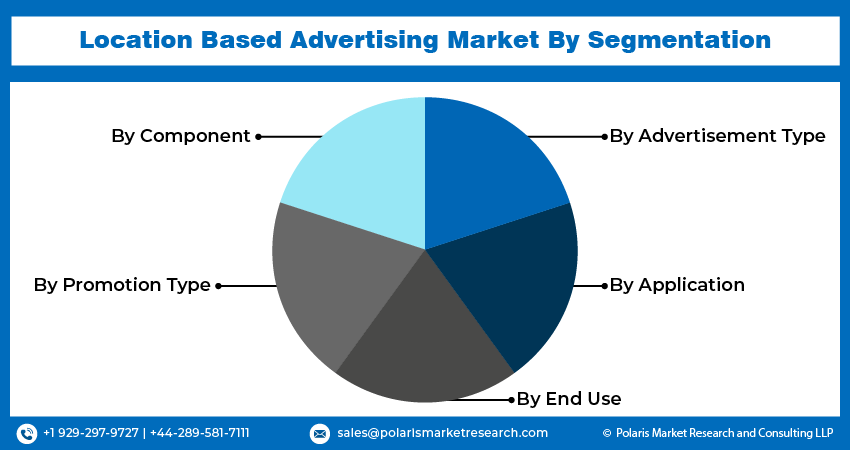
Location Based Advertising Market Share, Size, Trends, Industry Analysis Report, By Component (Geofencing, Geotargeting, Beacon Advertising, Geoconquesting), By Advertisement Type, By Promotion Type, By Application, By End Use, And Segment Forecasts, 2024 - 2032
- Published Date:Jan-2024
- Pages: 117
- Format: PDF
- Report ID: PM3967
- Base Year: 2023
- Historical Data: 2019-2022
Report Outlook
The global location-based advertising market was valued at USD 110.29 billion in 2023 and is expected to grow at a CAGR of 15.0% during the forecast period.
The market is capitalizing on geographic information to provide customized content and deals to consumers. This growth is propelled by widespread use of the mobile devices, advancements in geospatial technology, and the rising demand for personalized marketing interactions. Smartphones have fundamentally altered how consumers engage with information and brands, expanding the scope of advertising significantly. Mobile devices serve as primary sources of location data, allowing advertisers to deliver timely and relevant messages tailored to specific contexts. The continuous technological advancements remain a key driver behind the market's expansion.
The market research report offers an in-depth analysis of the industry to support informed decision-making. It offers a meticulous breakdown of various market niches and keeps readers updated on the latest industry developments. Along with tracking the Location Based Advertising Market on the basis of SWOT and Porter’s Five Forces models, the research report includes graphs, tables, charts, and other pictorial representations to help readers understand the key insights and important data easily.

To Understand More About this Research: Request a Free Sample Report
With the increasing connectivity and tech awareness among consumers, their demands for personalized advertising have grown substantially. This shift arises from a desire for interactions that are relevant and contextually meaningful, enhancing their lives. In this dynamic environment, grasping and fulfilling these personalized expectations is crucial for brands aiming to amplify the impact of their advertising endeavors. Consumers now anticipate advertisements to align with their distinct preferences, interests, and behaviors. They value brands that invest effort in comprehending their individual requirements. For example, an e-commerce platform suggesting products based on a user's browsing and buying history showcases a dedication to delivering a customized experience.
Industry Dynamics
Growth Drivers
- Technological advancements
The advancement of technologies like Global Positioning System (GPS), Near Field Communication (NFC), & beacon technology has enhanced accuracy in pinpointing a user's location. This precision is vital for delivering timely and pertinent advertisements. Location-based services provide extensive data on consumer behavior and preferences. By employing analytics and Artificial Intelligence (AI), advertisers gain valuable insights into consumer actions and likes. These insights help refine targeting strategies, enhance campaign effectiveness, and make well-informed marketing choices. The location-based advertising market is experiencing rapid growth due to the rising demand for personalized consumer experiences.

Report Segmentation
The market is primarily segmented based on component, promotion type, advertisement type, application, end use, and region.
|
By Component |
By Promotion Type |
By Advertisement Type |
By Application |
By End Use |
By Region |
|
|
|
|
|
|
|
To Understand the Scope of this Report: Speak to Analyst
By Component Analysis
- Geofencing segment accounted for the largest share in 2022
Geofencing segment held the largest share. It employs technologies like GPS, RFID, Wi-Fi, or cellular data to create virtual boundaries around specific locations. This allows businesses to send precisely targeted, contextually relevant messages to consumers within these defined areas. The remarkable expansion of geofencing components is set to persist, primarily propelled by ongoing technological advancements.
The swift progress in GPS precision, along with the incorporation of Wi-Fi and cellular data, has elevated the precision of geofencing capabilities. This enhanced accuracy empowers businesses to establish smaller and more precise virtual boundaries, amplifying the effectiveness of their advertising endeavors. For example, the fusion of geofencing with beacon technology facilitates highly localized interactions within a geofenced zone. This integration enables detailed indoor navigation, proximity-triggered notifications, and interactive engagements in settings such as retail outlets or museums.
By Promotion Type Analysis
- Search result promotion segment held the largest share in 2022
Search result promotion segment held the largest revenue share. The widespread adoption of smartphones integrated with GPS technology has significantly contributed to the market's growth. This technology empowers businesses to pinpoint consumers based on their exact geographic positions, facilitating the delivery of exceptionally pertinent and timely content. With smartphones becoming omnipresent, the potential scope of location-based advertising continues to expand.
Geofencing technology enables businesses to establish virtual boundaries around physical locations. When a user enters these areas, they can receive notifications, offers, or promotions tailored to that location, a strategy known as proximity marketing. This method has become popular in sectors like retail, hospitality, and events. In advertising, search result promotion ensures users receive content closely aligned with their immediate needs. For instance, a user searching for nearby coffee shops is more likely to engage with search results offering information about nearby cafes rather than generic listings.
By Advertisement Type Analysis
- Push advertising segment is expected to grow prominently over the forecast period.
Push advertising segment held the largest revenue share. he widespread embrace of GPS technology has been pivotal in the push advertising market. This technology enables real-time tracking of a user's location, facilitating highly precise and timely push notifications. When integrated with geofencing, which establishes virtual perimeters around physical locations, advertisers can send notifications as users enter or leave specific areas. This synergy of technologies heightens the relevance and efficiency of push advertising initiatives.
The expansion of data analytics tools has been a key factor in the push advertising sector's growth. These tools empower advertisers to process enormous data volumes instantly, enabling them to segment their audience based on factors like location, demographics, and behavior. This precise targeting guarantees that push notifications reach users most likely to find them pertinent, enhancing the likelihood of engagement and conversion.
By Application Analysis
- Public places segment held the largest share over forecast period
Public places segment held the largest revenue share. Public space applications have made significant impacts in diverse areas such as travel, retail, entertainment, and social networking. They stand out for their ability to offer highly localized content and services, elevating user engagement by providing pertinent and timely information. This fosters stronger connections between businesses and their audience, resulting in increased conversion rates and customer loyalty. Additionally, these applications generate valuable data related to user behavior, preferences, and movement patterns.
This information holds immense value for businesses aiming to comprehend their target demographic and enhance their advertising approaches. Furthermore, it empowers advertisers to assess the impact of their campaigns with unparalleled precision. The incorporation of Augmented Reality (AR) & Virtual Reality (VR) technologies into public space applications has ushered in a new era for location-based advertising. Brands now can craft immersive experiences seamlessly merging with the real world, enabling interactive and unforgettable engagements with consumers.

Regional Insights
- The demand in North America garnered the largest share in 2022
The North America region dominated the global market. The primary catalyst for this regional growth was the extensive use of smartphones. Due to the widespread adoption of mobile devices, consumers have become more interconnected and dependent on their phones for diverse activities such as shopping, socializing, and gathering information.
Asia Pacific will grow at rapid pace. This is primarily due to presence of reliable and precise geospatial data has significantly contributed to the region's expansion. With a sophisticated digital infrastructure encompassing GPS technology, Wi-Fi networks, & advanced mapping services, advertisers can pinpoint consumers' real-time locations accurately. This precision facilitates the delivery of highly pertinent and contextually rich advertising interactions.

Key Market Players & Competitive Insights
Stakeholders in the location-based advertising supply chain, strategic initiatives encompass collaborations between navigation platform providers and network operators, offering a comprehensive array of location-based services, enhancing expansion efforts, engaging in mergers and acquisitions, and establishing partnerships and agreements, among other approaches. Emerging startups like Locately, Vistar Media, & Skyhook are poised to present significant competition to established players in the realm of location-based services.
Some of the major players operating in the global market include:
- Cidewalk Technologies Inc.
- Enradius
- Emodo (Placecast)
- Facebook (Meta Platforms Inc.
- Foursquare
- Google LLC
- GroundTruth
- IBM Corporation
- Near Intelligence Inc.
- PlaceIQ
- Telenity
- Yelp Inc.
- Cuebiq Group LLC
Recent Developments
- In August 2023, Google introduced vehicle ads, a fresh advertising format in search, enabling automotive advertisers to showcase their vehicle inventory to users browsing for cars on Google.
- In March 2023, Cidewalk Technologies introduced BannerAI, a digital billboard ad creative service powered by OpenAI, available for free. This service complements their latest programmatic billboard advertising platform with real-time bidding capabilities.
- In May 2023, Foursquare launched Foursquare Graphs, a product designed to enhance data accuracy by improving information like geocodes and scores, including Venue Reality Score. This tool assists businesses in answering crucial questions while navigating evolving privacy concerns and respecting consumer privacy.
Location Based Advertising Market Report Scope
|
Report Attributes |
Details |
|
Market size value in 2024 |
USD 126.70 billion |
|
Revenue forecast in 2032 |
USD 386.77 billion |
|
CAGR |
15.0% from 2024 – 2032 |
|
Base year |
2023 |
|
Historical data |
2019 – 2022 |
|
Forecast period |
2024– 2032 |
|
Quantitative units |
Revenue in USD billion and CAGR from 2024 to 2032 |
|
Segments covered |
By Component, Promotion Type, Advertisement Type, Application, End Use, By Region |
|
Regional scope |
North America, Europe, Asia Pacific, Latin America; Middle East & Africa |
|
Customization |
Report customization as per your requirements with respect to countries, region and segmentation. |
Delve into the intricacies of Non-Invasive Prenatal Testing in 2024 through the meticulously compiled market share, size, and revenue growth rate statistics by Polaris Market Research Industry Reports. Uncover a comprehensive analysis that not only projects market trends up to 2032 but also provides valuable insights into the historical landscape. Immerse yourself in the depth of this industry analysis by acquiring a complimentary PDF download of the sample report.
Browse Our Top Selling Reports
Healthcare Cybersecurity Market Size, Share 2024 Research Report
Dental Suction Systems Market Size, Share 2024 Research Report
Infertility Treatment Market Size, Share 2024 Research Report
Enteric Disease Testing Market Size, Share 2024 Research Report
Bioimpedance Analyzers Market Size, Share 2024 Research Report
